Benefits of HRM Practices for Employer and Employee
VerifiedAdded on 2023/01/06
|16
|4877
|21
AI Summary
This article discusses the benefits of different HRM practices, such as reward management and training and development, for both employers and employees. It explains how these practices can increase organizational profit and productivity. The article also provides insights into the effectiveness of these practices in improving employee performance and motivation.
Contribute Materials
Your contribution can guide someone’s learning journey. Share your
documents today.
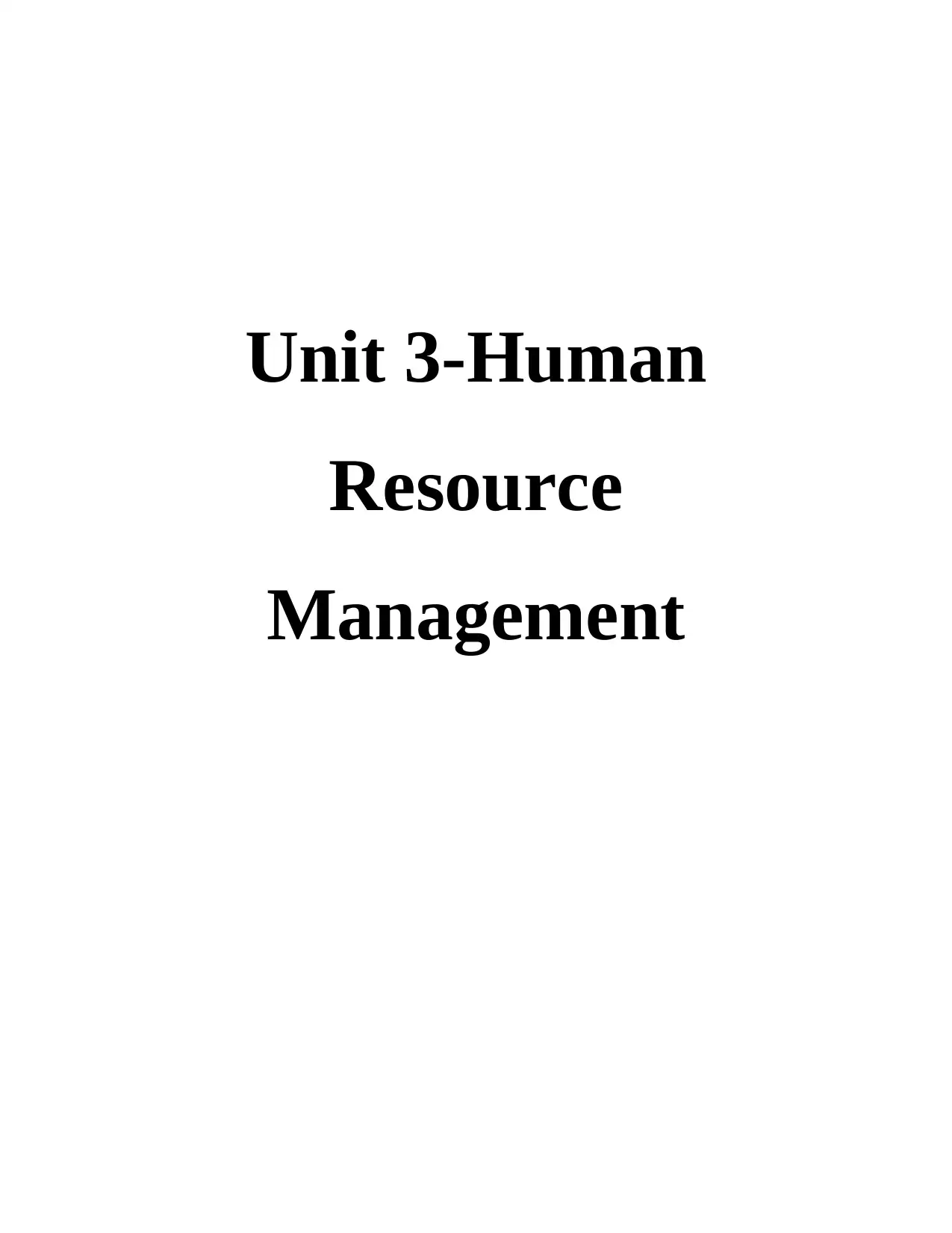
Unit 3-Human
Resource
Management
Resource
Management
Secure Best Marks with AI Grader
Need help grading? Try our AI Grader for instant feedback on your assignments.
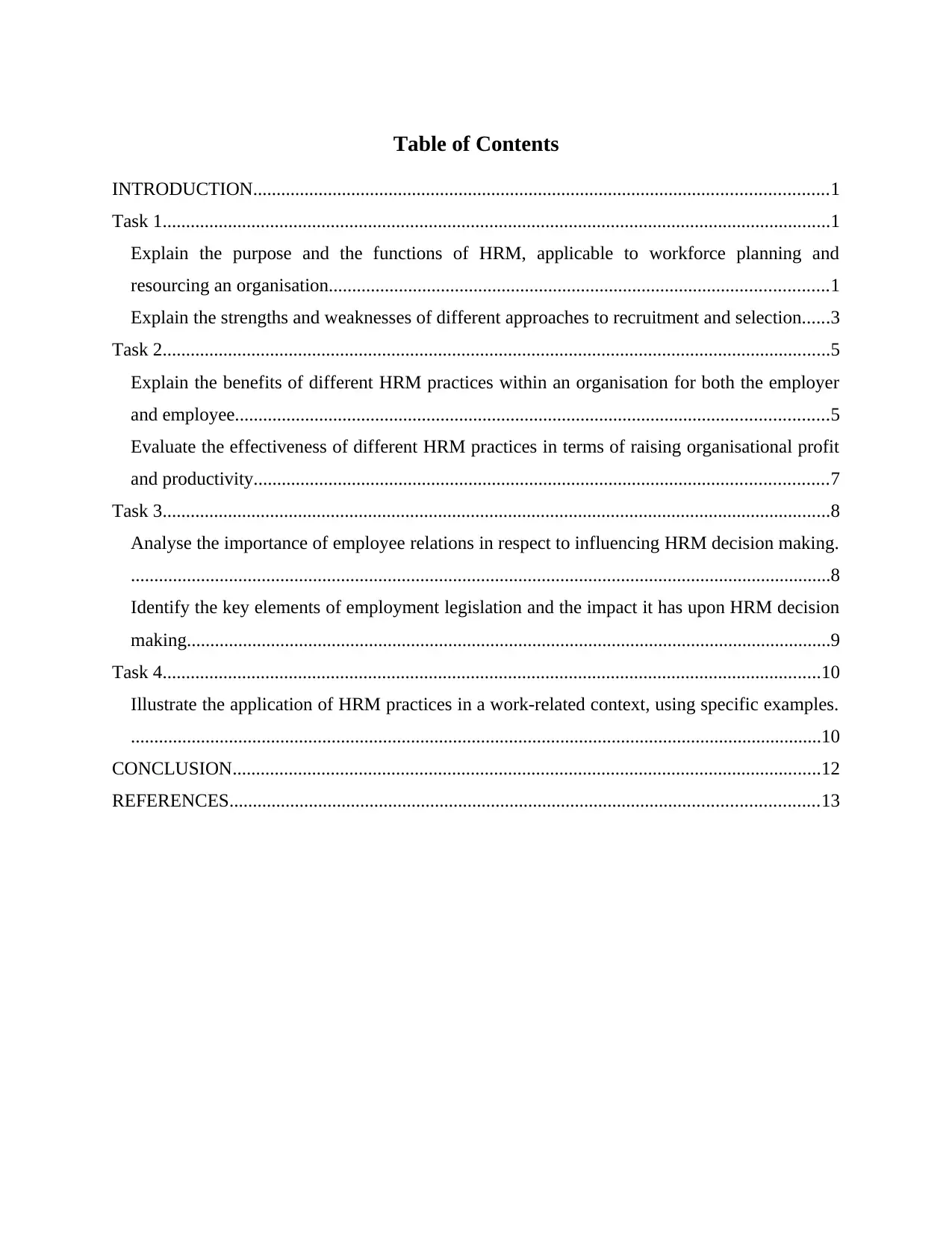
Table of Contents
INTRODUCTION...........................................................................................................................1
Task 1...............................................................................................................................................1
Explain the purpose and the functions of HRM, applicable to workforce planning and
resourcing an organisation...........................................................................................................1
Explain the strengths and weaknesses of different approaches to recruitment and selection......3
Task 2...............................................................................................................................................5
Explain the benefits of different HRM practices within an organisation for both the employer
and employee...............................................................................................................................5
Evaluate the effectiveness of different HRM practices in terms of raising organisational profit
and productivity...........................................................................................................................7
Task 3...............................................................................................................................................8
Analyse the importance of employee relations in respect to influencing HRM decision making.
......................................................................................................................................................8
Identify the key elements of employment legislation and the impact it has upon HRM decision
making..........................................................................................................................................9
Task 4.............................................................................................................................................10
Illustrate the application of HRM practices in a work-related context, using specific examples.
....................................................................................................................................................10
CONCLUSION..............................................................................................................................12
REFERENCES..............................................................................................................................13
INTRODUCTION...........................................................................................................................1
Task 1...............................................................................................................................................1
Explain the purpose and the functions of HRM, applicable to workforce planning and
resourcing an organisation...........................................................................................................1
Explain the strengths and weaknesses of different approaches to recruitment and selection......3
Task 2...............................................................................................................................................5
Explain the benefits of different HRM practices within an organisation for both the employer
and employee...............................................................................................................................5
Evaluate the effectiveness of different HRM practices in terms of raising organisational profit
and productivity...........................................................................................................................7
Task 3...............................................................................................................................................8
Analyse the importance of employee relations in respect to influencing HRM decision making.
......................................................................................................................................................8
Identify the key elements of employment legislation and the impact it has upon HRM decision
making..........................................................................................................................................9
Task 4.............................................................................................................................................10
Illustrate the application of HRM practices in a work-related context, using specific examples.
....................................................................................................................................................10
CONCLUSION..............................................................................................................................12
REFERENCES..............................................................................................................................13
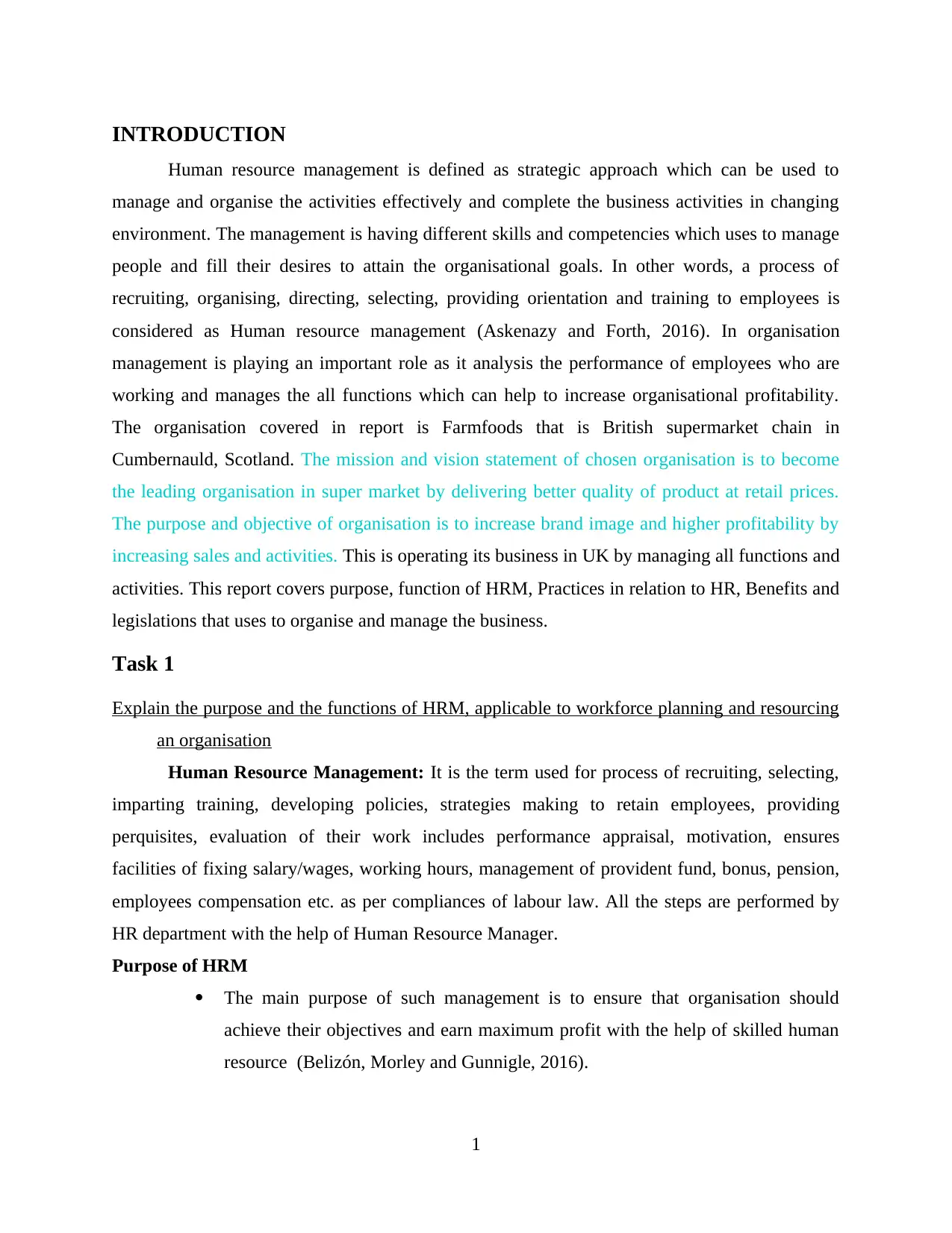
INTRODUCTION
Human resource management is defined as strategic approach which can be used to
manage and organise the activities effectively and complete the business activities in changing
environment. The management is having different skills and competencies which uses to manage
people and fill their desires to attain the organisational goals. In other words, a process of
recruiting, organising, directing, selecting, providing orientation and training to employees is
considered as Human resource management (Askenazy and Forth, 2016). In organisation
management is playing an important role as it analysis the performance of employees who are
working and manages the all functions which can help to increase organisational profitability.
The organisation covered in report is Farmfoods that is British supermarket chain in
Cumbernauld, Scotland. The mission and vision statement of chosen organisation is to become
the leading organisation in super market by delivering better quality of product at retail prices.
The purpose and objective of organisation is to increase brand image and higher profitability by
increasing sales and activities. This is operating its business in UK by managing all functions and
activities. This report covers purpose, function of HRM, Practices in relation to HR, Benefits and
legislations that uses to organise and manage the business.
Task 1
Explain the purpose and the functions of HRM, applicable to workforce planning and resourcing
an organisation
Human Resource Management: It is the term used for process of recruiting, selecting,
imparting training, developing policies, strategies making to retain employees, providing
perquisites, evaluation of their work includes performance appraisal, motivation, ensures
facilities of fixing salary/wages, working hours, management of provident fund, bonus, pension,
employees compensation etc. as per compliances of labour law. All the steps are performed by
HR department with the help of Human Resource Manager.
Purpose of HRM
The main purpose of such management is to ensure that organisation should
achieve their objectives and earn maximum profit with the help of skilled human
resource (Belizón, Morley and Gunnigle, 2016).
1
Human resource management is defined as strategic approach which can be used to
manage and organise the activities effectively and complete the business activities in changing
environment. The management is having different skills and competencies which uses to manage
people and fill their desires to attain the organisational goals. In other words, a process of
recruiting, organising, directing, selecting, providing orientation and training to employees is
considered as Human resource management (Askenazy and Forth, 2016). In organisation
management is playing an important role as it analysis the performance of employees who are
working and manages the all functions which can help to increase organisational profitability.
The organisation covered in report is Farmfoods that is British supermarket chain in
Cumbernauld, Scotland. The mission and vision statement of chosen organisation is to become
the leading organisation in super market by delivering better quality of product at retail prices.
The purpose and objective of organisation is to increase brand image and higher profitability by
increasing sales and activities. This is operating its business in UK by managing all functions and
activities. This report covers purpose, function of HRM, Practices in relation to HR, Benefits and
legislations that uses to organise and manage the business.
Task 1
Explain the purpose and the functions of HRM, applicable to workforce planning and resourcing
an organisation
Human Resource Management: It is the term used for process of recruiting, selecting,
imparting training, developing policies, strategies making to retain employees, providing
perquisites, evaluation of their work includes performance appraisal, motivation, ensures
facilities of fixing salary/wages, working hours, management of provident fund, bonus, pension,
employees compensation etc. as per compliances of labour law. All the steps are performed by
HR department with the help of Human Resource Manager.
Purpose of HRM
The main purpose of such management is to ensure that organisation should
achieve their objectives and earn maximum profit with the help of skilled human
resource (Belizón, Morley and Gunnigle, 2016).
1
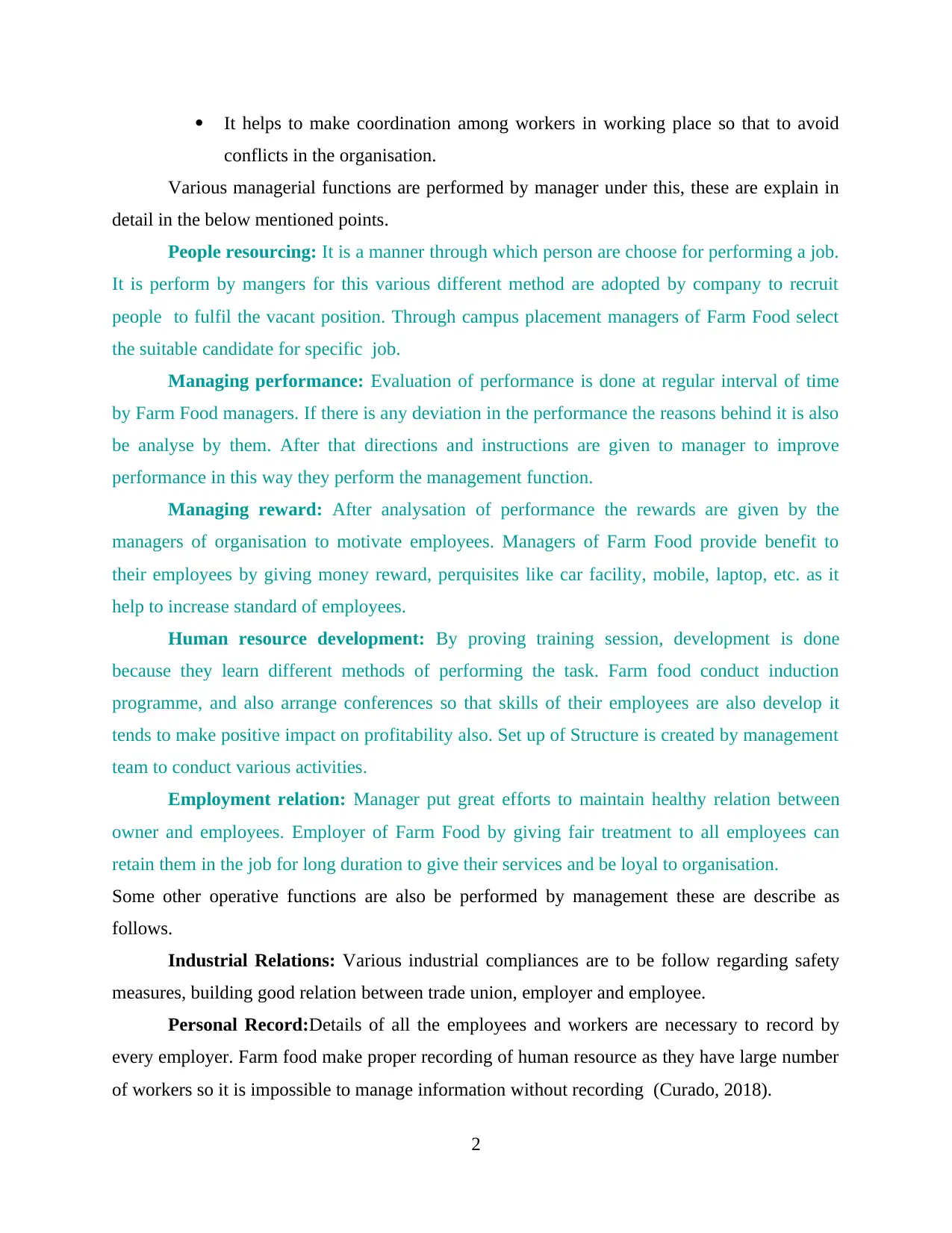
It helps to make coordination among workers in working place so that to avoid
conflicts in the organisation.
Various managerial functions are performed by manager under this, these are explain in
detail in the below mentioned points.
People resourcing: It is a manner through which person are choose for performing a job.
It is perform by mangers for this various different method are adopted by company to recruit
people to fulfil the vacant position. Through campus placement managers of Farm Food select
the suitable candidate for specific job.
Managing performance: Evaluation of performance is done at regular interval of time
by Farm Food managers. If there is any deviation in the performance the reasons behind it is also
be analyse by them. After that directions and instructions are given to manager to improve
performance in this way they perform the management function.
Managing reward: After analysation of performance the rewards are given by the
managers of organisation to motivate employees. Managers of Farm Food provide benefit to
their employees by giving money reward, perquisites like car facility, mobile, laptop, etc. as it
help to increase standard of employees.
Human resource development: By proving training session, development is done
because they learn different methods of performing the task. Farm food conduct induction
programme, and also arrange conferences so that skills of their employees are also develop it
tends to make positive impact on profitability also. Set up of Structure is created by management
team to conduct various activities.
Employment relation: Manager put great efforts to maintain healthy relation between
owner and employees. Employer of Farm Food by giving fair treatment to all employees can
retain them in the job for long duration to give their services and be loyal to organisation.
Some other operative functions are also be performed by management these are describe as
follows.
Industrial Relations: Various industrial compliances are to be follow regarding safety
measures, building good relation between trade union, employer and employee.
Personal Record:Details of all the employees and workers are necessary to record by
every employer. Farm food make proper recording of human resource as they have large number
of workers so it is impossible to manage information without recording (Curado, 2018).
2
conflicts in the organisation.
Various managerial functions are performed by manager under this, these are explain in
detail in the below mentioned points.
People resourcing: It is a manner through which person are choose for performing a job.
It is perform by mangers for this various different method are adopted by company to recruit
people to fulfil the vacant position. Through campus placement managers of Farm Food select
the suitable candidate for specific job.
Managing performance: Evaluation of performance is done at regular interval of time
by Farm Food managers. If there is any deviation in the performance the reasons behind it is also
be analyse by them. After that directions and instructions are given to manager to improve
performance in this way they perform the management function.
Managing reward: After analysation of performance the rewards are given by the
managers of organisation to motivate employees. Managers of Farm Food provide benefit to
their employees by giving money reward, perquisites like car facility, mobile, laptop, etc. as it
help to increase standard of employees.
Human resource development: By proving training session, development is done
because they learn different methods of performing the task. Farm food conduct induction
programme, and also arrange conferences so that skills of their employees are also develop it
tends to make positive impact on profitability also. Set up of Structure is created by management
team to conduct various activities.
Employment relation: Manager put great efforts to maintain healthy relation between
owner and employees. Employer of Farm Food by giving fair treatment to all employees can
retain them in the job for long duration to give their services and be loyal to organisation.
Some other operative functions are also be performed by management these are describe as
follows.
Industrial Relations: Various industrial compliances are to be follow regarding safety
measures, building good relation between trade union, employer and employee.
Personal Record:Details of all the employees and workers are necessary to record by
every employer. Farm food make proper recording of human resource as they have large number
of workers so it is impossible to manage information without recording (Curado, 2018).
2
Secure Best Marks with AI Grader
Need help grading? Try our AI Grader for instant feedback on your assignments.
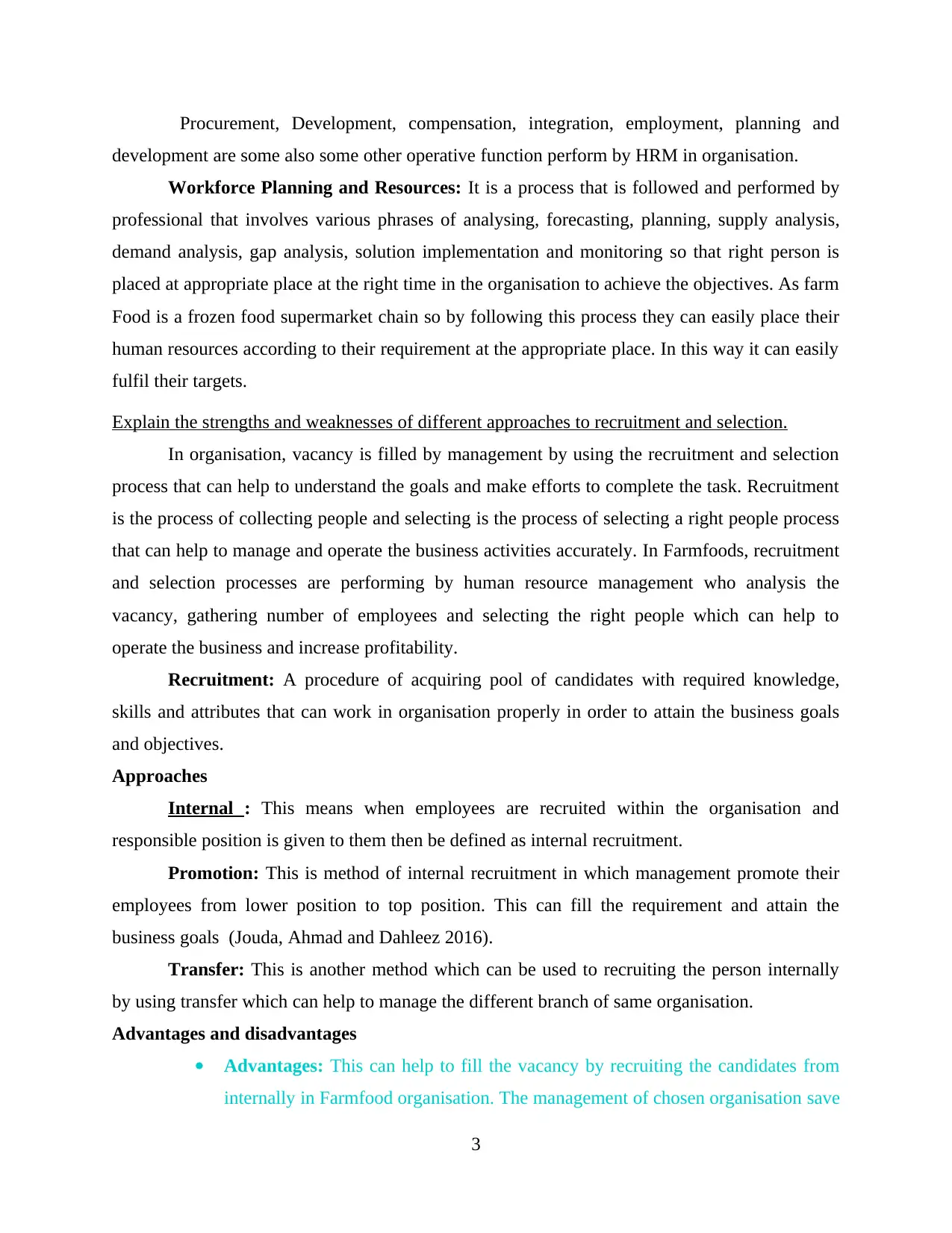
Procurement, Development, compensation, integration, employment, planning and
development are some also some other operative function perform by HRM in organisation.
Workforce Planning and Resources: It is a process that is followed and performed by
professional that involves various phrases of analysing, forecasting, planning, supply analysis,
demand analysis, gap analysis, solution implementation and monitoring so that right person is
placed at appropriate place at the right time in the organisation to achieve the objectives. As farm
Food is a frozen food supermarket chain so by following this process they can easily place their
human resources according to their requirement at the appropriate place. In this way it can easily
fulfil their targets.
Explain the strengths and weaknesses of different approaches to recruitment and selection.
In organisation, vacancy is filled by management by using the recruitment and selection
process that can help to understand the goals and make efforts to complete the task. Recruitment
is the process of collecting people and selecting is the process of selecting a right people process
that can help to manage and operate the business activities accurately. In Farmfoods, recruitment
and selection processes are performing by human resource management who analysis the
vacancy, gathering number of employees and selecting the right people which can help to
operate the business and increase profitability.
Recruitment: A procedure of acquiring pool of candidates with required knowledge,
skills and attributes that can work in organisation properly in order to attain the business goals
and objectives.
Approaches
Internal : This means when employees are recruited within the organisation and
responsible position is given to them then be defined as internal recruitment.
Promotion: This is method of internal recruitment in which management promote their
employees from lower position to top position. This can fill the requirement and attain the
business goals (Jouda, Ahmad and Dahleez 2016).
Transfer: This is another method which can be used to recruiting the person internally
by using transfer which can help to manage the different branch of same organisation.
Advantages and disadvantages
Advantages: This can help to fill the vacancy by recruiting the candidates from
internally in Farmfood organisation. The management of chosen organisation save
3
development are some also some other operative function perform by HRM in organisation.
Workforce Planning and Resources: It is a process that is followed and performed by
professional that involves various phrases of analysing, forecasting, planning, supply analysis,
demand analysis, gap analysis, solution implementation and monitoring so that right person is
placed at appropriate place at the right time in the organisation to achieve the objectives. As farm
Food is a frozen food supermarket chain so by following this process they can easily place their
human resources according to their requirement at the appropriate place. In this way it can easily
fulfil their targets.
Explain the strengths and weaknesses of different approaches to recruitment and selection.
In organisation, vacancy is filled by management by using the recruitment and selection
process that can help to understand the goals and make efforts to complete the task. Recruitment
is the process of collecting people and selecting is the process of selecting a right people process
that can help to manage and operate the business activities accurately. In Farmfoods, recruitment
and selection processes are performing by human resource management who analysis the
vacancy, gathering number of employees and selecting the right people which can help to
operate the business and increase profitability.
Recruitment: A procedure of acquiring pool of candidates with required knowledge,
skills and attributes that can work in organisation properly in order to attain the business goals
and objectives.
Approaches
Internal : This means when employees are recruited within the organisation and
responsible position is given to them then be defined as internal recruitment.
Promotion: This is method of internal recruitment in which management promote their
employees from lower position to top position. This can fill the requirement and attain the
business goals (Jouda, Ahmad and Dahleez 2016).
Transfer: This is another method which can be used to recruiting the person internally
by using transfer which can help to manage the different branch of same organisation.
Advantages and disadvantages
Advantages: This can help to fill the vacancy by recruiting the candidates from
internally in Farmfood organisation. The management of chosen organisation save
3
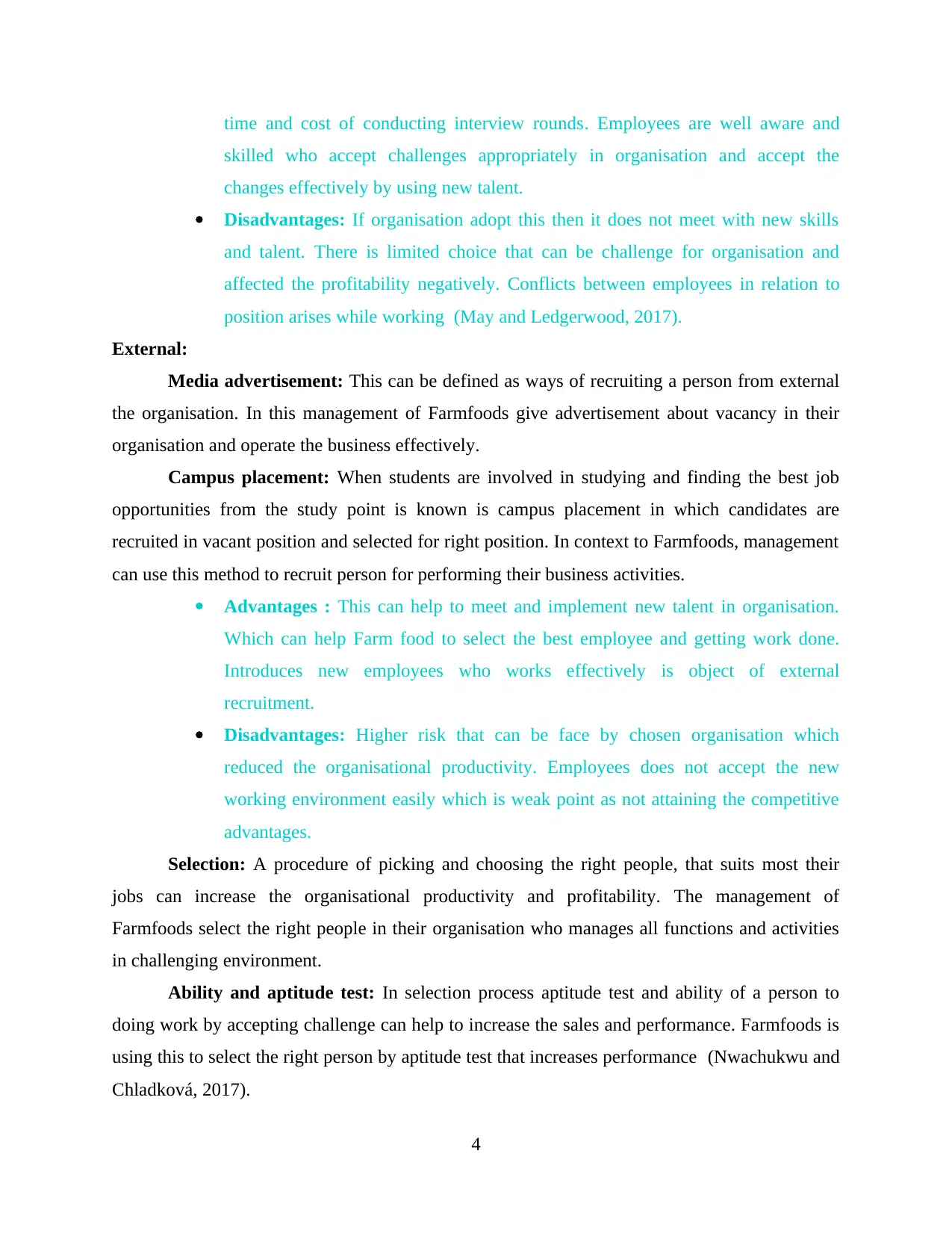
time and cost of conducting interview rounds. Employees are well aware and
skilled who accept challenges appropriately in organisation and accept the
changes effectively by using new talent.
Disadvantages: If organisation adopt this then it does not meet with new skills
and talent. There is limited choice that can be challenge for organisation and
affected the profitability negatively. Conflicts between employees in relation to
position arises while working (May and Ledgerwood, 2017).
External:
Media advertisement: This can be defined as ways of recruiting a person from external
the organisation. In this management of Farmfoods give advertisement about vacancy in their
organisation and operate the business effectively.
Campus placement: When students are involved in studying and finding the best job
opportunities from the study point is known is campus placement in which candidates are
recruited in vacant position and selected for right position. In context to Farmfoods, management
can use this method to recruit person for performing their business activities.
Advantages : This can help to meet and implement new talent in organisation.
Which can help Farm food to select the best employee and getting work done.
Introduces new employees who works effectively is object of external
recruitment.
Disadvantages: Higher risk that can be face by chosen organisation which
reduced the organisational productivity. Employees does not accept the new
working environment easily which is weak point as not attaining the competitive
advantages.
Selection: A procedure of picking and choosing the right people, that suits most their
jobs can increase the organisational productivity and profitability. The management of
Farmfoods select the right people in their organisation who manages all functions and activities
in challenging environment.
Ability and aptitude test: In selection process aptitude test and ability of a person to
doing work by accepting challenge can help to increase the sales and performance. Farmfoods is
using this to select the right person by aptitude test that increases performance (Nwachukwu and
Chladková, 2017).
4
skilled who accept challenges appropriately in organisation and accept the
changes effectively by using new talent.
Disadvantages: If organisation adopt this then it does not meet with new skills
and talent. There is limited choice that can be challenge for organisation and
affected the profitability negatively. Conflicts between employees in relation to
position arises while working (May and Ledgerwood, 2017).
External:
Media advertisement: This can be defined as ways of recruiting a person from external
the organisation. In this management of Farmfoods give advertisement about vacancy in their
organisation and operate the business effectively.
Campus placement: When students are involved in studying and finding the best job
opportunities from the study point is known is campus placement in which candidates are
recruited in vacant position and selected for right position. In context to Farmfoods, management
can use this method to recruit person for performing their business activities.
Advantages : This can help to meet and implement new talent in organisation.
Which can help Farm food to select the best employee and getting work done.
Introduces new employees who works effectively is object of external
recruitment.
Disadvantages: Higher risk that can be face by chosen organisation which
reduced the organisational productivity. Employees does not accept the new
working environment easily which is weak point as not attaining the competitive
advantages.
Selection: A procedure of picking and choosing the right people, that suits most their
jobs can increase the organisational productivity and profitability. The management of
Farmfoods select the right people in their organisation who manages all functions and activities
in challenging environment.
Ability and aptitude test: In selection process aptitude test and ability of a person to
doing work by accepting challenge can help to increase the sales and performance. Farmfoods is
using this to select the right person by aptitude test that increases performance (Nwachukwu and
Chladková, 2017).
4
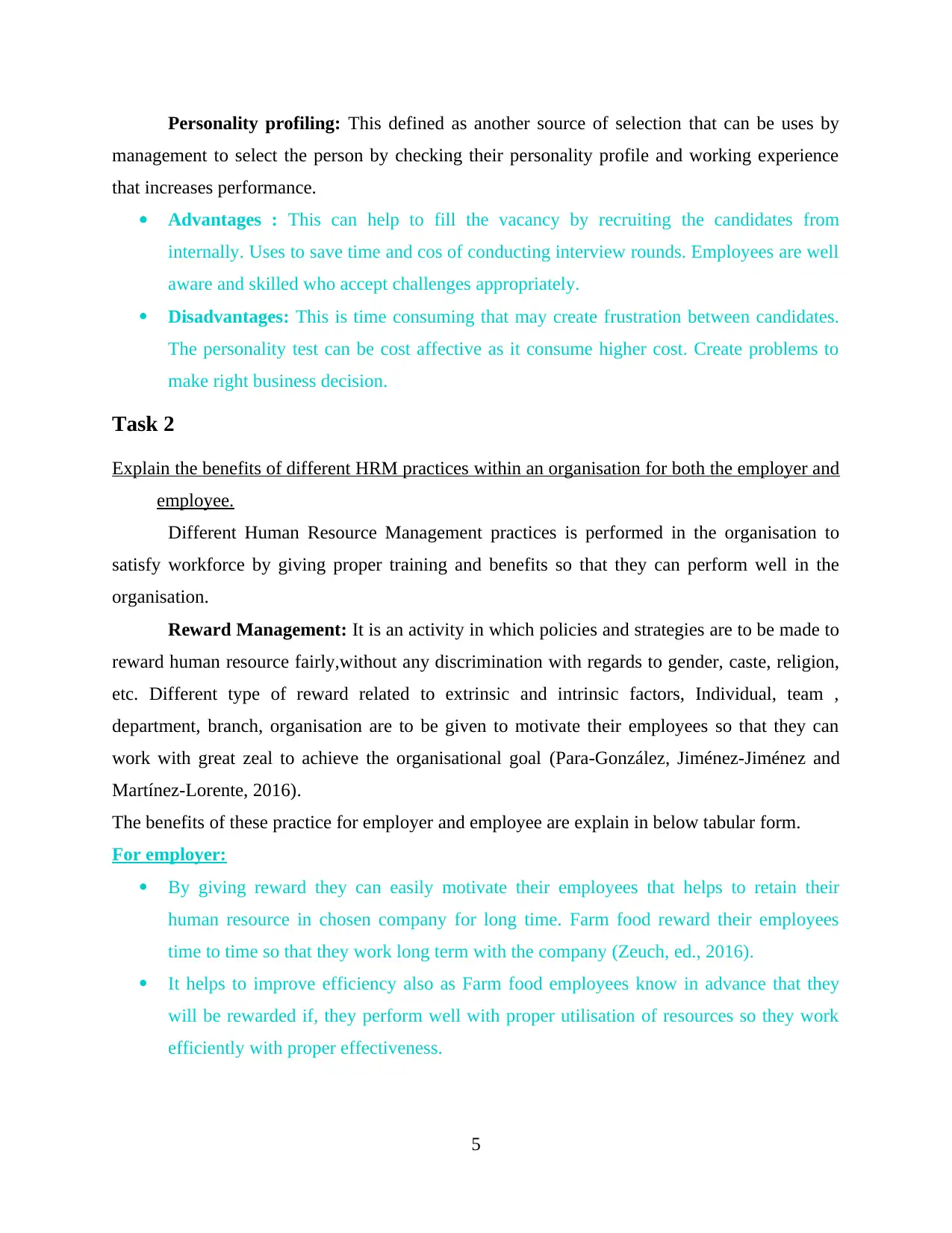
Personality profiling: This defined as another source of selection that can be uses by
management to select the person by checking their personality profile and working experience
that increases performance.
Advantages : This can help to fill the vacancy by recruiting the candidates from
internally. Uses to save time and cos of conducting interview rounds. Employees are well
aware and skilled who accept challenges appropriately.
Disadvantages: This is time consuming that may create frustration between candidates.
The personality test can be cost affective as it consume higher cost. Create problems to
make right business decision.
Task 2
Explain the benefits of different HRM practices within an organisation for both the employer and
employee.
Different Human Resource Management practices is performed in the organisation to
satisfy workforce by giving proper training and benefits so that they can perform well in the
organisation.
Reward Management: It is an activity in which policies and strategies are to be made to
reward human resource fairly,without any discrimination with regards to gender, caste, religion,
etc. Different type of reward related to extrinsic and intrinsic factors, Individual, team ,
department, branch, organisation are to be given to motivate their employees so that they can
work with great zeal to achieve the organisational goal (Para-González, Jiménez-Jiménez and
Martínez-Lorente, 2016).
The benefits of these practice for employer and employee are explain in below tabular form.
For employer:
By giving reward they can easily motivate their employees that helps to retain their
human resource in chosen company for long time. Farm food reward their employees
time to time so that they work long term with the company (Zeuch, ed., 2016).
It helps to improve efficiency also as Farm food employees know in advance that they
will be rewarded if, they perform well with proper utilisation of resources so they work
efficiently with proper effectiveness.
5
management to select the person by checking their personality profile and working experience
that increases performance.
Advantages : This can help to fill the vacancy by recruiting the candidates from
internally. Uses to save time and cos of conducting interview rounds. Employees are well
aware and skilled who accept challenges appropriately.
Disadvantages: This is time consuming that may create frustration between candidates.
The personality test can be cost affective as it consume higher cost. Create problems to
make right business decision.
Task 2
Explain the benefits of different HRM practices within an organisation for both the employer and
employee.
Different Human Resource Management practices is performed in the organisation to
satisfy workforce by giving proper training and benefits so that they can perform well in the
organisation.
Reward Management: It is an activity in which policies and strategies are to be made to
reward human resource fairly,without any discrimination with regards to gender, caste, religion,
etc. Different type of reward related to extrinsic and intrinsic factors, Individual, team ,
department, branch, organisation are to be given to motivate their employees so that they can
work with great zeal to achieve the organisational goal (Para-González, Jiménez-Jiménez and
Martínez-Lorente, 2016).
The benefits of these practice for employer and employee are explain in below tabular form.
For employer:
By giving reward they can easily motivate their employees that helps to retain their
human resource in chosen company for long time. Farm food reward their employees
time to time so that they work long term with the company (Zeuch, ed., 2016).
It helps to improve efficiency also as Farm food employees know in advance that they
will be rewarded if, they perform well with proper utilisation of resources so they work
efficiently with proper effectiveness.
5
Paraphrase This Document
Need a fresh take? Get an instant paraphrase of this document with our AI Paraphraser
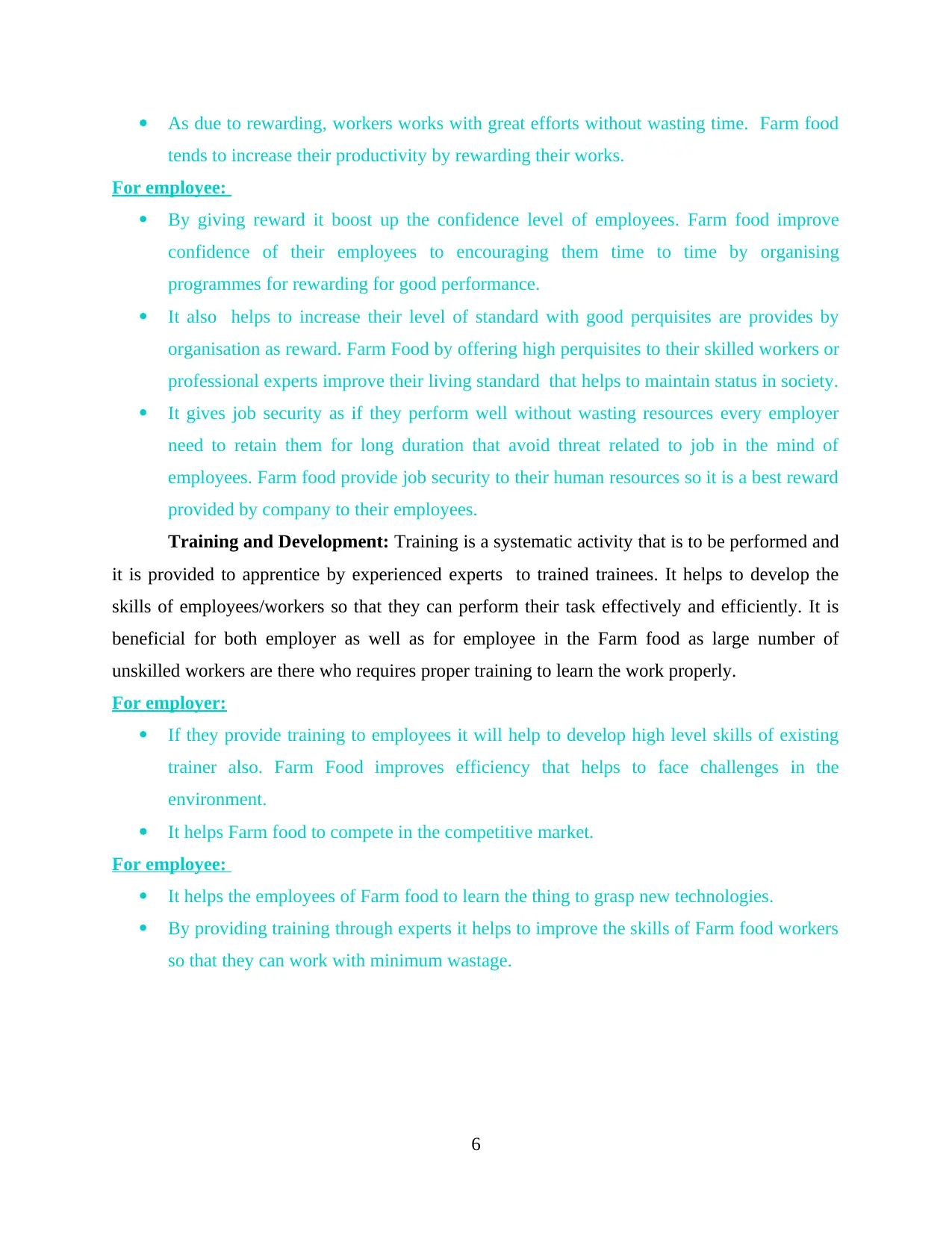
As due to rewarding, workers works with great efforts without wasting time. Farm food
tends to increase their productivity by rewarding their works.
For employee:
By giving reward it boost up the confidence level of employees. Farm food improve
confidence of their employees to encouraging them time to time by organising
programmes for rewarding for good performance.
It also helps to increase their level of standard with good perquisites are provides by
organisation as reward. Farm Food by offering high perquisites to their skilled workers or
professional experts improve their living standard that helps to maintain status in society.
It gives job security as if they perform well without wasting resources every employer
need to retain them for long duration that avoid threat related to job in the mind of
employees. Farm food provide job security to their human resources so it is a best reward
provided by company to their employees.
Training and Development: Training is a systematic activity that is to be performed and
it is provided to apprentice by experienced experts to trained trainees. It helps to develop the
skills of employees/workers so that they can perform their task effectively and efficiently. It is
beneficial for both employer as well as for employee in the Farm food as large number of
unskilled workers are there who requires proper training to learn the work properly.
For employer:
If they provide training to employees it will help to develop high level skills of existing
trainer also. Farm Food improves efficiency that helps to face challenges in the
environment.
It helps Farm food to compete in the competitive market.
For employee:
It helps the employees of Farm food to learn the thing to grasp new technologies.
By providing training through experts it helps to improve the skills of Farm food workers
so that they can work with minimum wastage.
6
tends to increase their productivity by rewarding their works.
For employee:
By giving reward it boost up the confidence level of employees. Farm food improve
confidence of their employees to encouraging them time to time by organising
programmes for rewarding for good performance.
It also helps to increase their level of standard with good perquisites are provides by
organisation as reward. Farm Food by offering high perquisites to their skilled workers or
professional experts improve their living standard that helps to maintain status in society.
It gives job security as if they perform well without wasting resources every employer
need to retain them for long duration that avoid threat related to job in the mind of
employees. Farm food provide job security to their human resources so it is a best reward
provided by company to their employees.
Training and Development: Training is a systematic activity that is to be performed and
it is provided to apprentice by experienced experts to trained trainees. It helps to develop the
skills of employees/workers so that they can perform their task effectively and efficiently. It is
beneficial for both employer as well as for employee in the Farm food as large number of
unskilled workers are there who requires proper training to learn the work properly.
For employer:
If they provide training to employees it will help to develop high level skills of existing
trainer also. Farm Food improves efficiency that helps to face challenges in the
environment.
It helps Farm food to compete in the competitive market.
For employee:
It helps the employees of Farm food to learn the thing to grasp new technologies.
By providing training through experts it helps to improve the skills of Farm food workers
so that they can work with minimum wastage.
6
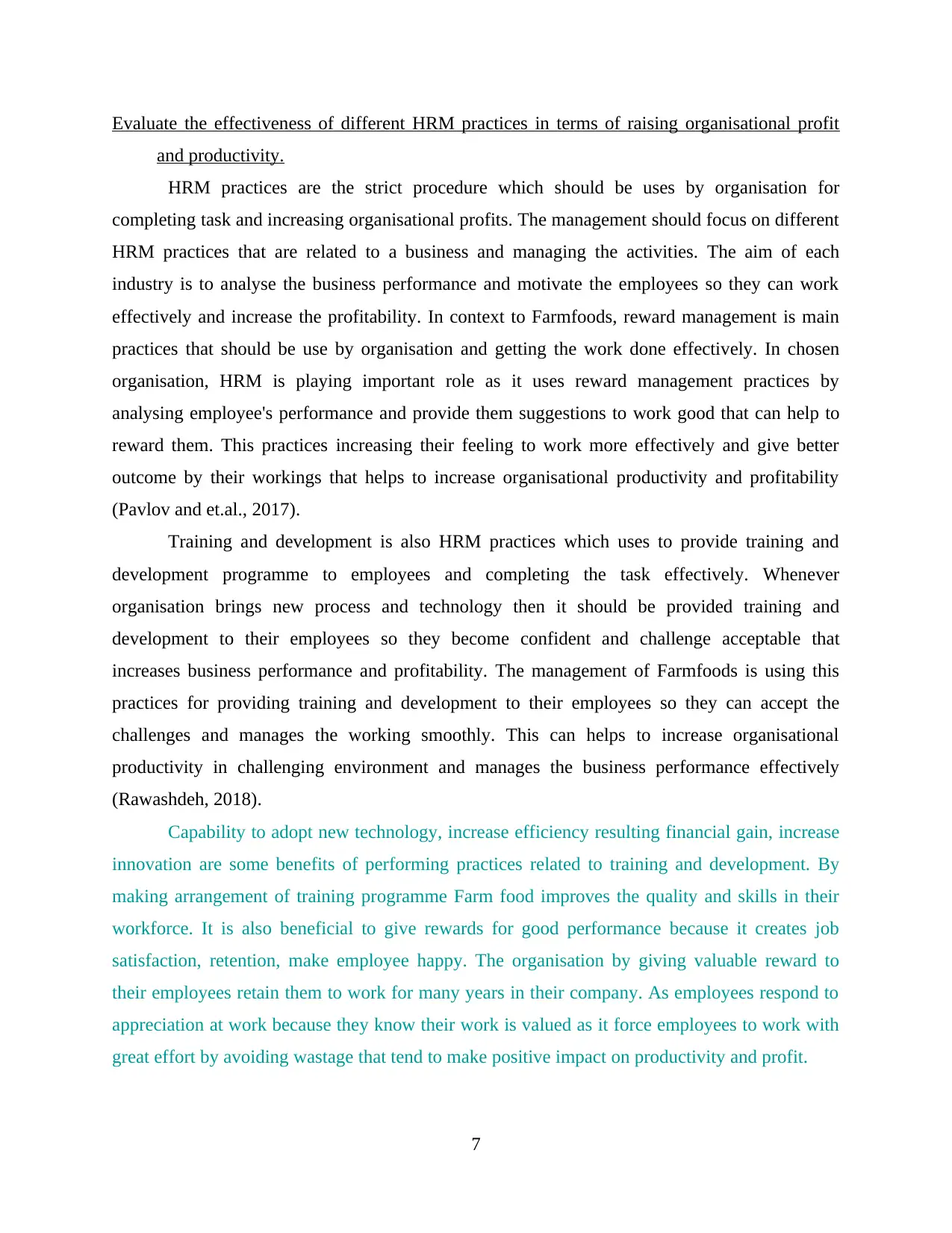
Evaluate the effectiveness of different HRM practices in terms of raising organisational profit
and productivity.
HRM practices are the strict procedure which should be uses by organisation for
completing task and increasing organisational profits. The management should focus on different
HRM practices that are related to a business and managing the activities. The aim of each
industry is to analyse the business performance and motivate the employees so they can work
effectively and increase the profitability. In context to Farmfoods, reward management is main
practices that should be use by organisation and getting the work done effectively. In chosen
organisation, HRM is playing important role as it uses reward management practices by
analysing employee's performance and provide them suggestions to work good that can help to
reward them. This practices increasing their feeling to work more effectively and give better
outcome by their workings that helps to increase organisational productivity and profitability
(Pavlov and et.al., 2017).
Training and development is also HRM practices which uses to provide training and
development programme to employees and completing the task effectively. Whenever
organisation brings new process and technology then it should be provided training and
development to their employees so they become confident and challenge acceptable that
increases business performance and profitability. The management of Farmfoods is using this
practices for providing training and development to their employees so they can accept the
challenges and manages the working smoothly. This can helps to increase organisational
productivity in challenging environment and manages the business performance effectively
(Rawashdeh, 2018).
Capability to adopt new technology, increase efficiency resulting financial gain, increase
innovation are some benefits of performing practices related to training and development. By
making arrangement of training programme Farm food improves the quality and skills in their
workforce. It is also beneficial to give rewards for good performance because it creates job
satisfaction, retention, make employee happy. The organisation by giving valuable reward to
their employees retain them to work for many years in their company. As employees respond to
appreciation at work because they know their work is valued as it force employees to work with
great effort by avoiding wastage that tend to make positive impact on productivity and profit.
7
and productivity.
HRM practices are the strict procedure which should be uses by organisation for
completing task and increasing organisational profits. The management should focus on different
HRM practices that are related to a business and managing the activities. The aim of each
industry is to analyse the business performance and motivate the employees so they can work
effectively and increase the profitability. In context to Farmfoods, reward management is main
practices that should be use by organisation and getting the work done effectively. In chosen
organisation, HRM is playing important role as it uses reward management practices by
analysing employee's performance and provide them suggestions to work good that can help to
reward them. This practices increasing their feeling to work more effectively and give better
outcome by their workings that helps to increase organisational productivity and profitability
(Pavlov and et.al., 2017).
Training and development is also HRM practices which uses to provide training and
development programme to employees and completing the task effectively. Whenever
organisation brings new process and technology then it should be provided training and
development to their employees so they become confident and challenge acceptable that
increases business performance and profitability. The management of Farmfoods is using this
practices for providing training and development to their employees so they can accept the
challenges and manages the working smoothly. This can helps to increase organisational
productivity in challenging environment and manages the business performance effectively
(Rawashdeh, 2018).
Capability to adopt new technology, increase efficiency resulting financial gain, increase
innovation are some benefits of performing practices related to training and development. By
making arrangement of training programme Farm food improves the quality and skills in their
workforce. It is also beneficial to give rewards for good performance because it creates job
satisfaction, retention, make employee happy. The organisation by giving valuable reward to
their employees retain them to work for many years in their company. As employees respond to
appreciation at work because they know their work is valued as it force employees to work with
great effort by avoiding wastage that tend to make positive impact on productivity and profit.
7
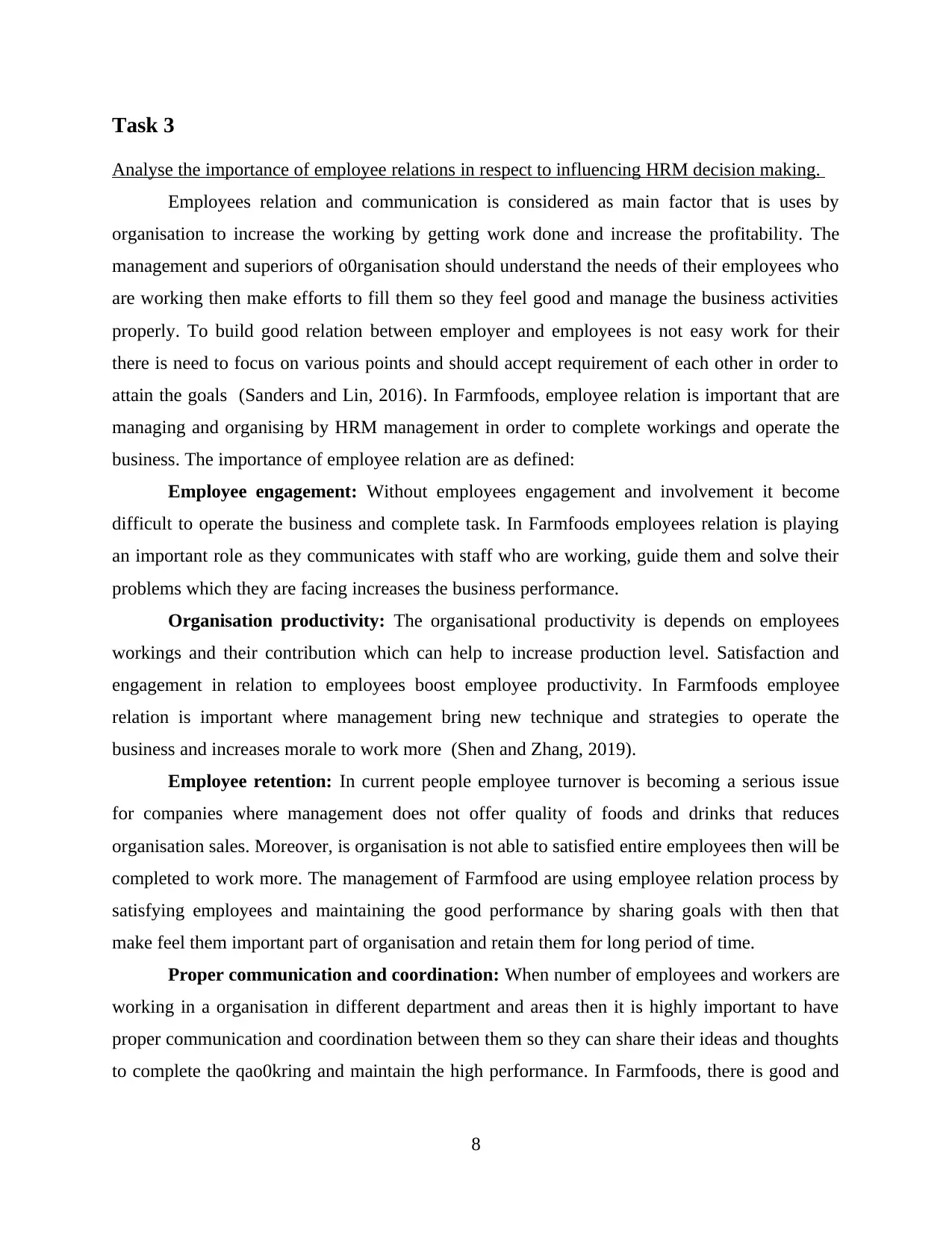
Task 3
Analyse the importance of employee relations in respect to influencing HRM decision making.
Employees relation and communication is considered as main factor that is uses by
organisation to increase the working by getting work done and increase the profitability. The
management and superiors of o0rganisation should understand the needs of their employees who
are working then make efforts to fill them so they feel good and manage the business activities
properly. To build good relation between employer and employees is not easy work for their
there is need to focus on various points and should accept requirement of each other in order to
attain the goals (Sanders and Lin, 2016). In Farmfoods, employee relation is important that are
managing and organising by HRM management in order to complete workings and operate the
business. The importance of employee relation are as defined:
Employee engagement: Without employees engagement and involvement it become
difficult to operate the business and complete task. In Farmfoods employees relation is playing
an important role as they communicates with staff who are working, guide them and solve their
problems which they are facing increases the business performance.
Organisation productivity: The organisational productivity is depends on employees
workings and their contribution which can help to increase production level. Satisfaction and
engagement in relation to employees boost employee productivity. In Farmfoods employee
relation is important where management bring new technique and strategies to operate the
business and increases morale to work more (Shen and Zhang, 2019).
Employee retention: In current people employee turnover is becoming a serious issue
for companies where management does not offer quality of foods and drinks that reduces
organisation sales. Moreover, is organisation is not able to satisfied entire employees then will be
completed to work more. The management of Farmfood are using employee relation process by
satisfying employees and maintaining the good performance by sharing goals with then that
make feel them important part of organisation and retain them for long period of time.
Proper communication and coordination: When number of employees and workers are
working in a organisation in different department and areas then it is highly important to have
proper communication and coordination between them so they can share their ideas and thoughts
to complete the qao0kring and maintain the high performance. In Farmfoods, there is good and
8
Analyse the importance of employee relations in respect to influencing HRM decision making.
Employees relation and communication is considered as main factor that is uses by
organisation to increase the working by getting work done and increase the profitability. The
management and superiors of o0rganisation should understand the needs of their employees who
are working then make efforts to fill them so they feel good and manage the business activities
properly. To build good relation between employer and employees is not easy work for their
there is need to focus on various points and should accept requirement of each other in order to
attain the goals (Sanders and Lin, 2016). In Farmfoods, employee relation is important that are
managing and organising by HRM management in order to complete workings and operate the
business. The importance of employee relation are as defined:
Employee engagement: Without employees engagement and involvement it become
difficult to operate the business and complete task. In Farmfoods employees relation is playing
an important role as they communicates with staff who are working, guide them and solve their
problems which they are facing increases the business performance.
Organisation productivity: The organisational productivity is depends on employees
workings and their contribution which can help to increase production level. Satisfaction and
engagement in relation to employees boost employee productivity. In Farmfoods employee
relation is important where management bring new technique and strategies to operate the
business and increases morale to work more (Shen and Zhang, 2019).
Employee retention: In current people employee turnover is becoming a serious issue
for companies where management does not offer quality of foods and drinks that reduces
organisation sales. Moreover, is organisation is not able to satisfied entire employees then will be
completed to work more. The management of Farmfood are using employee relation process by
satisfying employees and maintaining the good performance by sharing goals with then that
make feel them important part of organisation and retain them for long period of time.
Proper communication and coordination: When number of employees and workers are
working in a organisation in different department and areas then it is highly important to have
proper communication and coordination between them so they can share their ideas and thoughts
to complete the qao0kring and maintain the high performance. In Farmfoods, there is good and
8
Secure Best Marks with AI Grader
Need help grading? Try our AI Grader for instant feedback on your assignments.
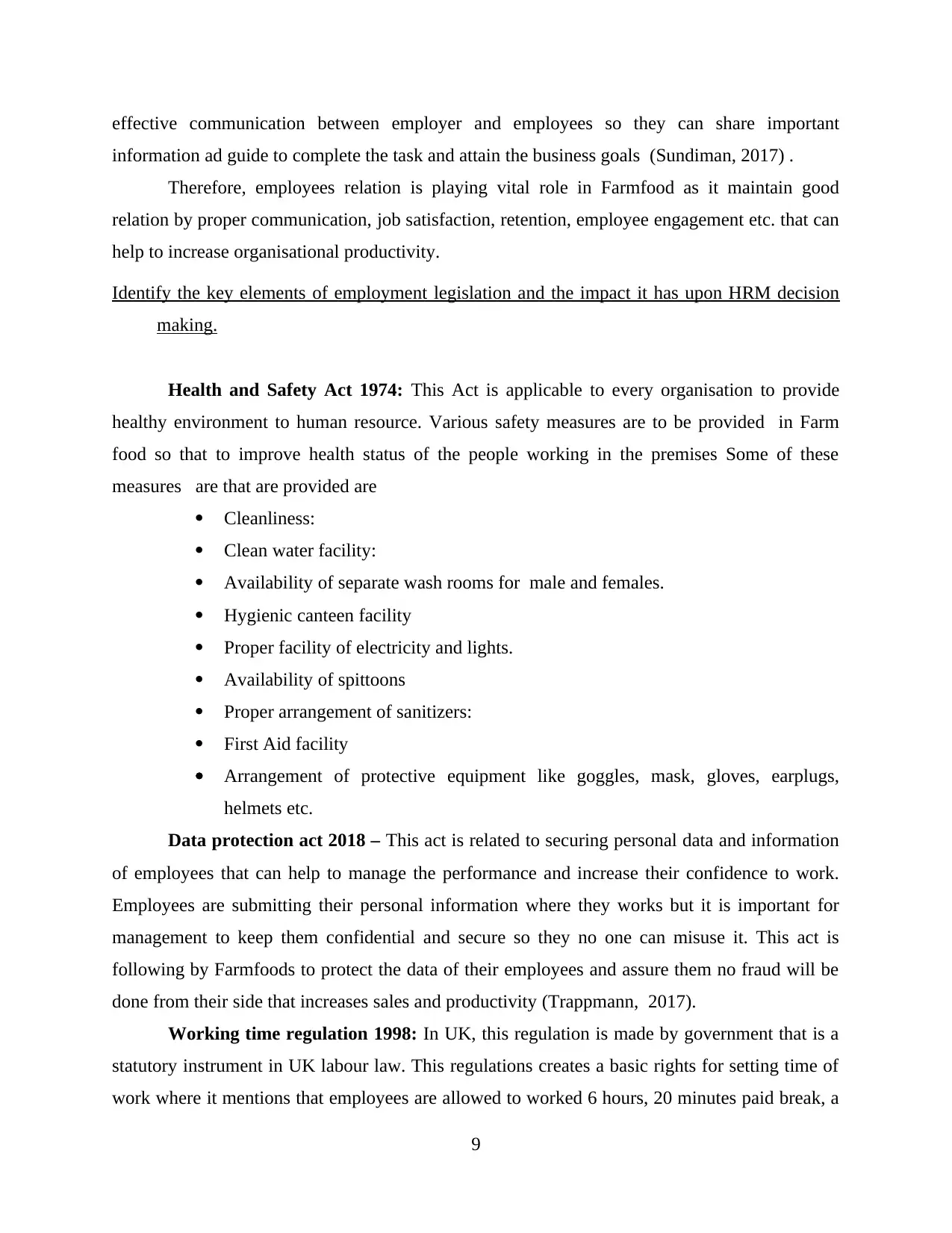
effective communication between employer and employees so they can share important
information ad guide to complete the task and attain the business goals (Sundiman, 2017) .
Therefore, employees relation is playing vital role in Farmfood as it maintain good
relation by proper communication, job satisfaction, retention, employee engagement etc. that can
help to increase organisational productivity.
Identify the key elements of employment legislation and the impact it has upon HRM decision
making.
Health and Safety Act 1974: This Act is applicable to every organisation to provide
healthy environment to human resource. Various safety measures are to be provided in Farm
food so that to improve health status of the people working in the premises Some of these
measures are that are provided are
Cleanliness:
Clean water facility:
Availability of separate wash rooms for male and females.
Hygienic canteen facility
Proper facility of electricity and lights.
Availability of spittoons
Proper arrangement of sanitizers:
First Aid facility
Arrangement of protective equipment like goggles, mask, gloves, earplugs,
helmets etc.
Data protection act 2018 – This act is related to securing personal data and information
of employees that can help to manage the performance and increase their confidence to work.
Employees are submitting their personal information where they works but it is important for
management to keep them confidential and secure so they no one can misuse it. This act is
following by Farmfoods to protect the data of their employees and assure them no fraud will be
done from their side that increases sales and productivity (Trappmann, 2017).
Working time regulation 1998: In UK, this regulation is made by government that is a
statutory instrument in UK labour law. This regulations creates a basic rights for setting time of
work where it mentions that employees are allowed to worked 6 hours, 20 minutes paid break, a
9
information ad guide to complete the task and attain the business goals (Sundiman, 2017) .
Therefore, employees relation is playing vital role in Farmfood as it maintain good
relation by proper communication, job satisfaction, retention, employee engagement etc. that can
help to increase organisational productivity.
Identify the key elements of employment legislation and the impact it has upon HRM decision
making.
Health and Safety Act 1974: This Act is applicable to every organisation to provide
healthy environment to human resource. Various safety measures are to be provided in Farm
food so that to improve health status of the people working in the premises Some of these
measures are that are provided are
Cleanliness:
Clean water facility:
Availability of separate wash rooms for male and females.
Hygienic canteen facility
Proper facility of electricity and lights.
Availability of spittoons
Proper arrangement of sanitizers:
First Aid facility
Arrangement of protective equipment like goggles, mask, gloves, earplugs,
helmets etc.
Data protection act 2018 – This act is related to securing personal data and information
of employees that can help to manage the performance and increase their confidence to work.
Employees are submitting their personal information where they works but it is important for
management to keep them confidential and secure so they no one can misuse it. This act is
following by Farmfoods to protect the data of their employees and assure them no fraud will be
done from their side that increases sales and productivity (Trappmann, 2017).
Working time regulation 1998: In UK, this regulation is made by government that is a
statutory instrument in UK labour law. This regulations creates a basic rights for setting time of
work where it mentions that employees are allowed to worked 6 hours, 20 minutes paid break, a
9
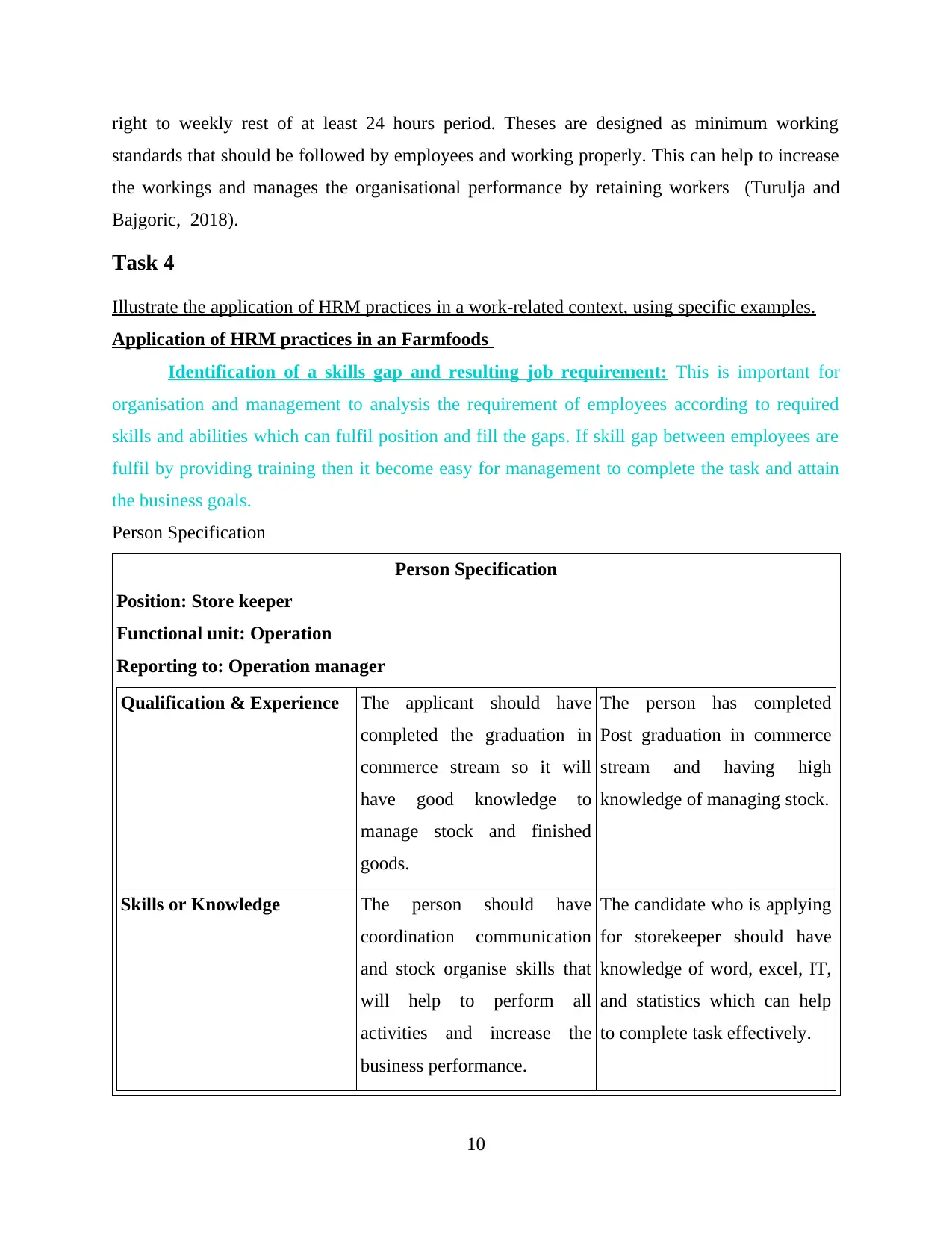
right to weekly rest of at least 24 hours period. Theses are designed as minimum working
standards that should be followed by employees and working properly. This can help to increase
the workings and manages the organisational performance by retaining workers (Turulja and
Bajgoric, 2018).
Task 4
Illustrate the application of HRM practices in a work-related context, using specific examples.
Application of HRM practices in an Farmfoods
Identification of a skills gap and resulting job requirement: This is important for
organisation and management to analysis the requirement of employees according to required
skills and abilities which can fulfil position and fill the gaps. If skill gap between employees are
fulfil by providing training then it become easy for management to complete the task and attain
the business goals.
Person Specification
Person Specification
Position: Store keeper
Functional unit: Operation
Reporting to: Operation manager
Qualification & Experience The applicant should have
completed the graduation in
commerce stream so it will
have good knowledge to
manage stock and finished
goods.
The person has completed
Post graduation in commerce
stream and having high
knowledge of managing stock.
Skills or Knowledge The person should have
coordination communication
and stock organise skills that
will help to perform all
activities and increase the
business performance.
The candidate who is applying
for storekeeper should have
knowledge of word, excel, IT,
and statistics which can help
to complete task effectively.
10
standards that should be followed by employees and working properly. This can help to increase
the workings and manages the organisational performance by retaining workers (Turulja and
Bajgoric, 2018).
Task 4
Illustrate the application of HRM practices in a work-related context, using specific examples.
Application of HRM practices in an Farmfoods
Identification of a skills gap and resulting job requirement: This is important for
organisation and management to analysis the requirement of employees according to required
skills and abilities which can fulfil position and fill the gaps. If skill gap between employees are
fulfil by providing training then it become easy for management to complete the task and attain
the business goals.
Person Specification
Person Specification
Position: Store keeper
Functional unit: Operation
Reporting to: Operation manager
Qualification & Experience The applicant should have
completed the graduation in
commerce stream so it will
have good knowledge to
manage stock and finished
goods.
The person has completed
Post graduation in commerce
stream and having high
knowledge of managing stock.
Skills or Knowledge The person should have
coordination communication
and stock organise skills that
will help to perform all
activities and increase the
business performance.
The candidate who is applying
for storekeeper should have
knowledge of word, excel, IT,
and statistics which can help
to complete task effectively.
10
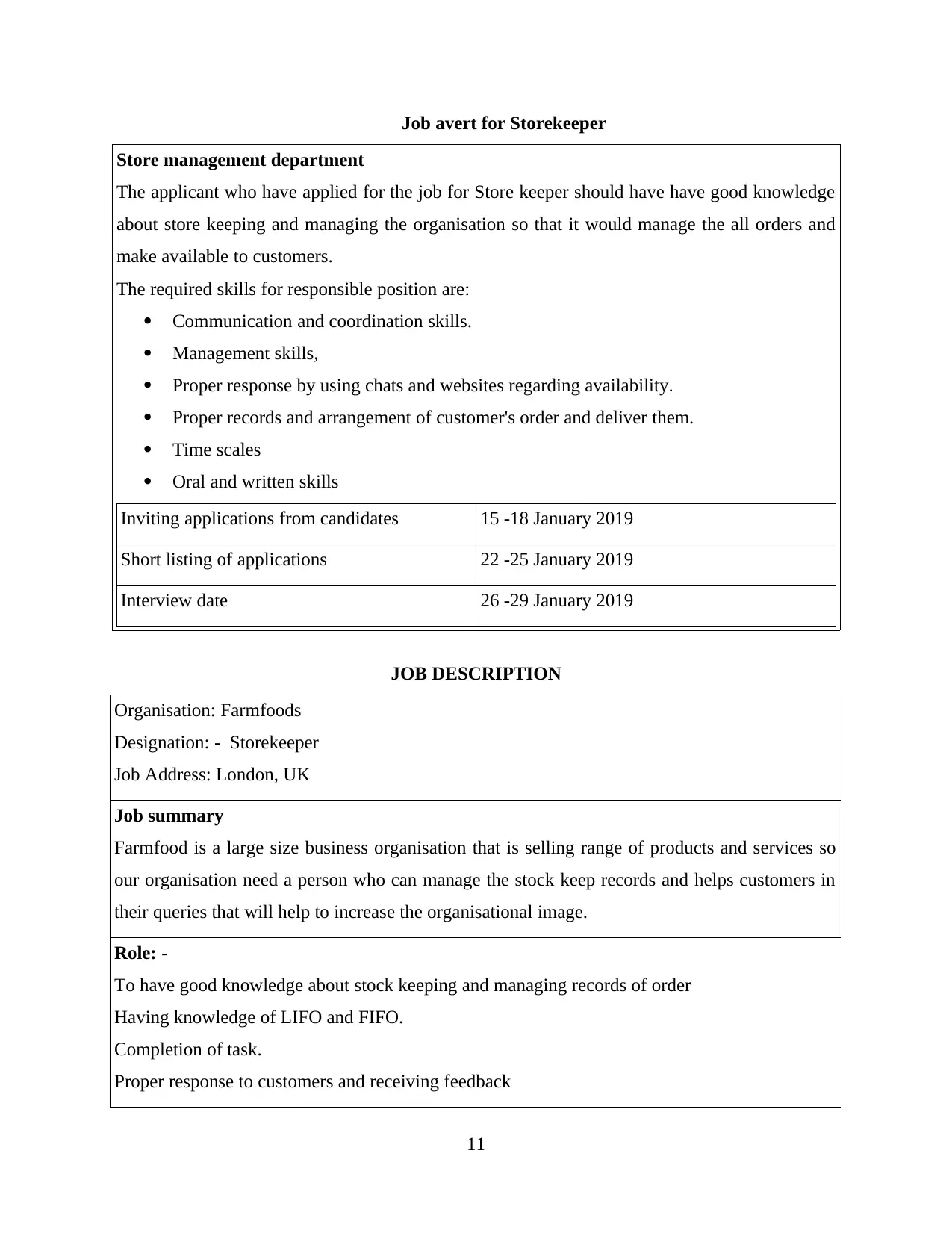
Job avert for Storekeeper
Store management department
The applicant who have applied for the job for Store keeper should have have good knowledge
about store keeping and managing the organisation so that it would manage the all orders and
make available to customers.
The required skills for responsible position are:
Communication and coordination skills.
Management skills,
Proper response by using chats and websites regarding availability.
Proper records and arrangement of customer's order and deliver them.
Time scales
Oral and written skills
Inviting applications from candidates 15 -18 January 2019
Short listing of applications 22 -25 January 2019
Interview date 26 -29 January 2019
JOB DESCRIPTION
Organisation: Farmfoods
Designation: - Storekeeper
Job Address: London, UK
Job summary
Farmfood is a large size business organisation that is selling range of products and services so
our organisation need a person who can manage the stock keep records and helps customers in
their queries that will help to increase the organisational image.
Role: -
To have good knowledge about stock keeping and managing records of order
Having knowledge of LIFO and FIFO.
Completion of task.
Proper response to customers and receiving feedback
11
Store management department
The applicant who have applied for the job for Store keeper should have have good knowledge
about store keeping and managing the organisation so that it would manage the all orders and
make available to customers.
The required skills for responsible position are:
Communication and coordination skills.
Management skills,
Proper response by using chats and websites regarding availability.
Proper records and arrangement of customer's order and deliver them.
Time scales
Oral and written skills
Inviting applications from candidates 15 -18 January 2019
Short listing of applications 22 -25 January 2019
Interview date 26 -29 January 2019
JOB DESCRIPTION
Organisation: Farmfoods
Designation: - Storekeeper
Job Address: London, UK
Job summary
Farmfood is a large size business organisation that is selling range of products and services so
our organisation need a person who can manage the stock keep records and helps customers in
their queries that will help to increase the organisational image.
Role: -
To have good knowledge about stock keeping and managing records of order
Having knowledge of LIFO and FIFO.
Completion of task.
Proper response to customers and receiving feedback
11
Paraphrase This Document
Need a fresh take? Get an instant paraphrase of this document with our AI Paraphraser
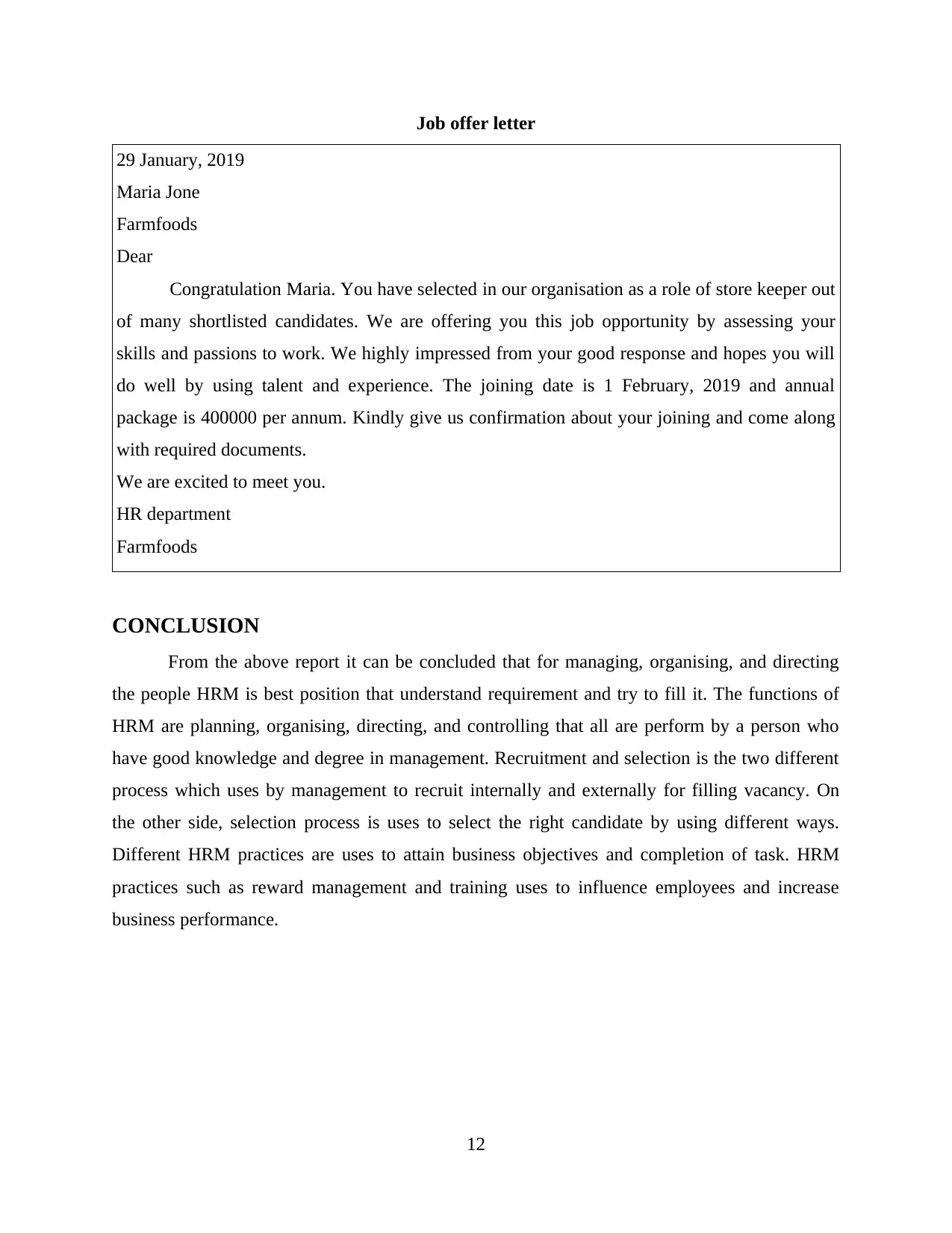
Job offer letter
29 January, 2019
Maria Jone
Farmfoods
Dear
Congratulation Maria. You have selected in our organisation as a role of store keeper out
of many shortlisted candidates. We are offering you this job opportunity by assessing your
skills and passions to work. We highly impressed from your good response and hopes you will
do well by using talent and experience. The joining date is 1 February, 2019 and annual
package is 400000 per annum. Kindly give us confirmation about your joining and come along
with required documents.
We are excited to meet you.
HR department
Farmfoods
CONCLUSION
From the above report it can be concluded that for managing, organising, and directing
the people HRM is best position that understand requirement and try to fill it. The functions of
HRM are planning, organising, directing, and controlling that all are perform by a person who
have good knowledge and degree in management. Recruitment and selection is the two different
process which uses by management to recruit internally and externally for filling vacancy. On
the other side, selection process is uses to select the right candidate by using different ways.
Different HRM practices are uses to attain business objectives and completion of task. HRM
practices such as reward management and training uses to influence employees and increase
business performance.
12
29 January, 2019
Maria Jone
Farmfoods
Dear
Congratulation Maria. You have selected in our organisation as a role of store keeper out
of many shortlisted candidates. We are offering you this job opportunity by assessing your
skills and passions to work. We highly impressed from your good response and hopes you will
do well by using talent and experience. The joining date is 1 February, 2019 and annual
package is 400000 per annum. Kindly give us confirmation about your joining and come along
with required documents.
We are excited to meet you.
HR department
Farmfoods
CONCLUSION
From the above report it can be concluded that for managing, organising, and directing
the people HRM is best position that understand requirement and try to fill it. The functions of
HRM are planning, organising, directing, and controlling that all are perform by a person who
have good knowledge and degree in management. Recruitment and selection is the two different
process which uses by management to recruit internally and externally for filling vacancy. On
the other side, selection process is uses to select the right candidate by using different ways.
Different HRM practices are uses to attain business objectives and completion of task. HRM
practices such as reward management and training uses to influence employees and increase
business performance.
12
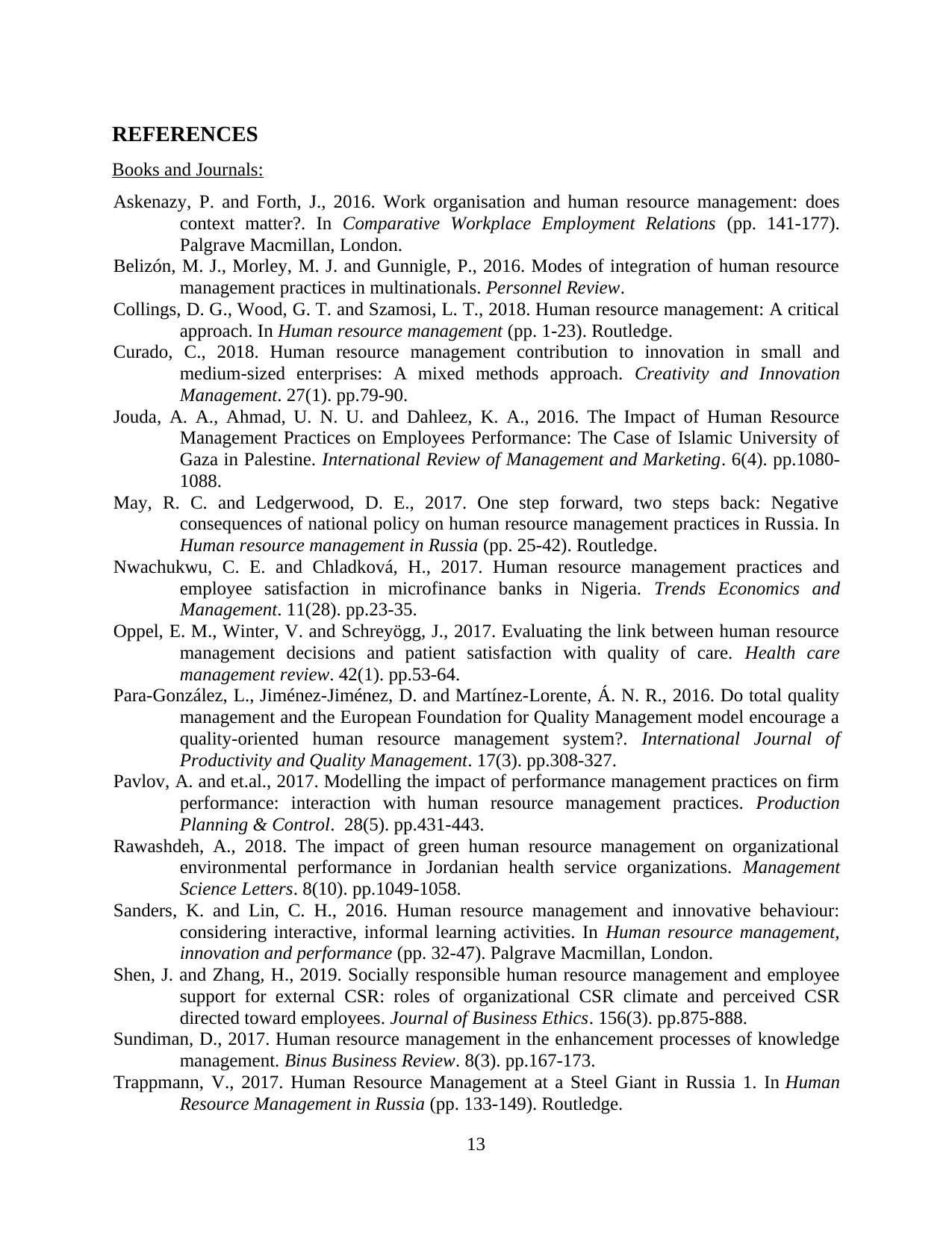
REFERENCES
Books and Journals:
Askenazy, P. and Forth, J., 2016. Work organisation and human resource management: does
context matter?. In Comparative Workplace Employment Relations (pp. 141-177).
Palgrave Macmillan, London.
Belizón, M. J., Morley, M. J. and Gunnigle, P., 2016. Modes of integration of human resource
management practices in multinationals. Personnel Review.
Collings, D. G., Wood, G. T. and Szamosi, L. T., 2018. Human resource management: A critical
approach. In Human resource management (pp. 1-23). Routledge.
Curado, C., 2018. Human resource management contribution to innovation in small and
medium‐sized enterprises: A mixed methods approach. Creativity and Innovation
Management. 27(1). pp.79-90.
Jouda, A. A., Ahmad, U. N. U. and Dahleez, K. A., 2016. The Impact of Human Resource
Management Practices on Employees Performance: The Case of Islamic University of
Gaza in Palestine. International Review of Management and Marketing. 6(4). pp.1080-
1088.
May, R. C. and Ledgerwood, D. E., 2017. One step forward, two steps back: Negative
consequences of national policy on human resource management practices in Russia. In
Human resource management in Russia (pp. 25-42). Routledge.
Nwachukwu, C. E. and Chladková, H., 2017. Human resource management practices and
employee satisfaction in microfinance banks in Nigeria. Trends Economics and
Management. 11(28). pp.23-35.
Oppel, E. M., Winter, V. and Schreyögg, J., 2017. Evaluating the link between human resource
management decisions and patient satisfaction with quality of care. Health care
management review. 42(1). pp.53-64.
Para-González, L., Jiménez-Jiménez, D. and Martínez-Lorente, Á. N. R., 2016. Do total quality
management and the European Foundation for Quality Management model encourage a
quality-oriented human resource management system?. International Journal of
Productivity and Quality Management. 17(3). pp.308-327.
Pavlov, A. and et.al., 2017. Modelling the impact of performance management practices on firm
performance: interaction with human resource management practices. Production
Planning & Control. 28(5). pp.431-443.
Rawashdeh, A., 2018. The impact of green human resource management on organizational
environmental performance in Jordanian health service organizations. Management
Science Letters. 8(10). pp.1049-1058.
Sanders, K. and Lin, C. H., 2016. Human resource management and innovative behaviour:
considering interactive, informal learning activities. In Human resource management,
innovation and performance (pp. 32-47). Palgrave Macmillan, London.
Shen, J. and Zhang, H., 2019. Socially responsible human resource management and employee
support for external CSR: roles of organizational CSR climate and perceived CSR
directed toward employees. Journal of Business Ethics. 156(3). pp.875-888.
Sundiman, D., 2017. Human resource management in the enhancement processes of knowledge
management. Binus Business Review. 8(3). pp.167-173.
Trappmann, V., 2017. Human Resource Management at a Steel Giant in Russia 1. In Human
Resource Management in Russia (pp. 133-149). Routledge.
13
Books and Journals:
Askenazy, P. and Forth, J., 2016. Work organisation and human resource management: does
context matter?. In Comparative Workplace Employment Relations (pp. 141-177).
Palgrave Macmillan, London.
Belizón, M. J., Morley, M. J. and Gunnigle, P., 2016. Modes of integration of human resource
management practices in multinationals. Personnel Review.
Collings, D. G., Wood, G. T. and Szamosi, L. T., 2018. Human resource management: A critical
approach. In Human resource management (pp. 1-23). Routledge.
Curado, C., 2018. Human resource management contribution to innovation in small and
medium‐sized enterprises: A mixed methods approach. Creativity and Innovation
Management. 27(1). pp.79-90.
Jouda, A. A., Ahmad, U. N. U. and Dahleez, K. A., 2016. The Impact of Human Resource
Management Practices on Employees Performance: The Case of Islamic University of
Gaza in Palestine. International Review of Management and Marketing. 6(4). pp.1080-
1088.
May, R. C. and Ledgerwood, D. E., 2017. One step forward, two steps back: Negative
consequences of national policy on human resource management practices in Russia. In
Human resource management in Russia (pp. 25-42). Routledge.
Nwachukwu, C. E. and Chladková, H., 2017. Human resource management practices and
employee satisfaction in microfinance banks in Nigeria. Trends Economics and
Management. 11(28). pp.23-35.
Oppel, E. M., Winter, V. and Schreyögg, J., 2017. Evaluating the link between human resource
management decisions and patient satisfaction with quality of care. Health care
management review. 42(1). pp.53-64.
Para-González, L., Jiménez-Jiménez, D. and Martínez-Lorente, Á. N. R., 2016. Do total quality
management and the European Foundation for Quality Management model encourage a
quality-oriented human resource management system?. International Journal of
Productivity and Quality Management. 17(3). pp.308-327.
Pavlov, A. and et.al., 2017. Modelling the impact of performance management practices on firm
performance: interaction with human resource management practices. Production
Planning & Control. 28(5). pp.431-443.
Rawashdeh, A., 2018. The impact of green human resource management on organizational
environmental performance in Jordanian health service organizations. Management
Science Letters. 8(10). pp.1049-1058.
Sanders, K. and Lin, C. H., 2016. Human resource management and innovative behaviour:
considering interactive, informal learning activities. In Human resource management,
innovation and performance (pp. 32-47). Palgrave Macmillan, London.
Shen, J. and Zhang, H., 2019. Socially responsible human resource management and employee
support for external CSR: roles of organizational CSR climate and perceived CSR
directed toward employees. Journal of Business Ethics. 156(3). pp.875-888.
Sundiman, D., 2017. Human resource management in the enhancement processes of knowledge
management. Binus Business Review. 8(3). pp.167-173.
Trappmann, V., 2017. Human Resource Management at a Steel Giant in Russia 1. In Human
Resource Management in Russia (pp. 133-149). Routledge.
13
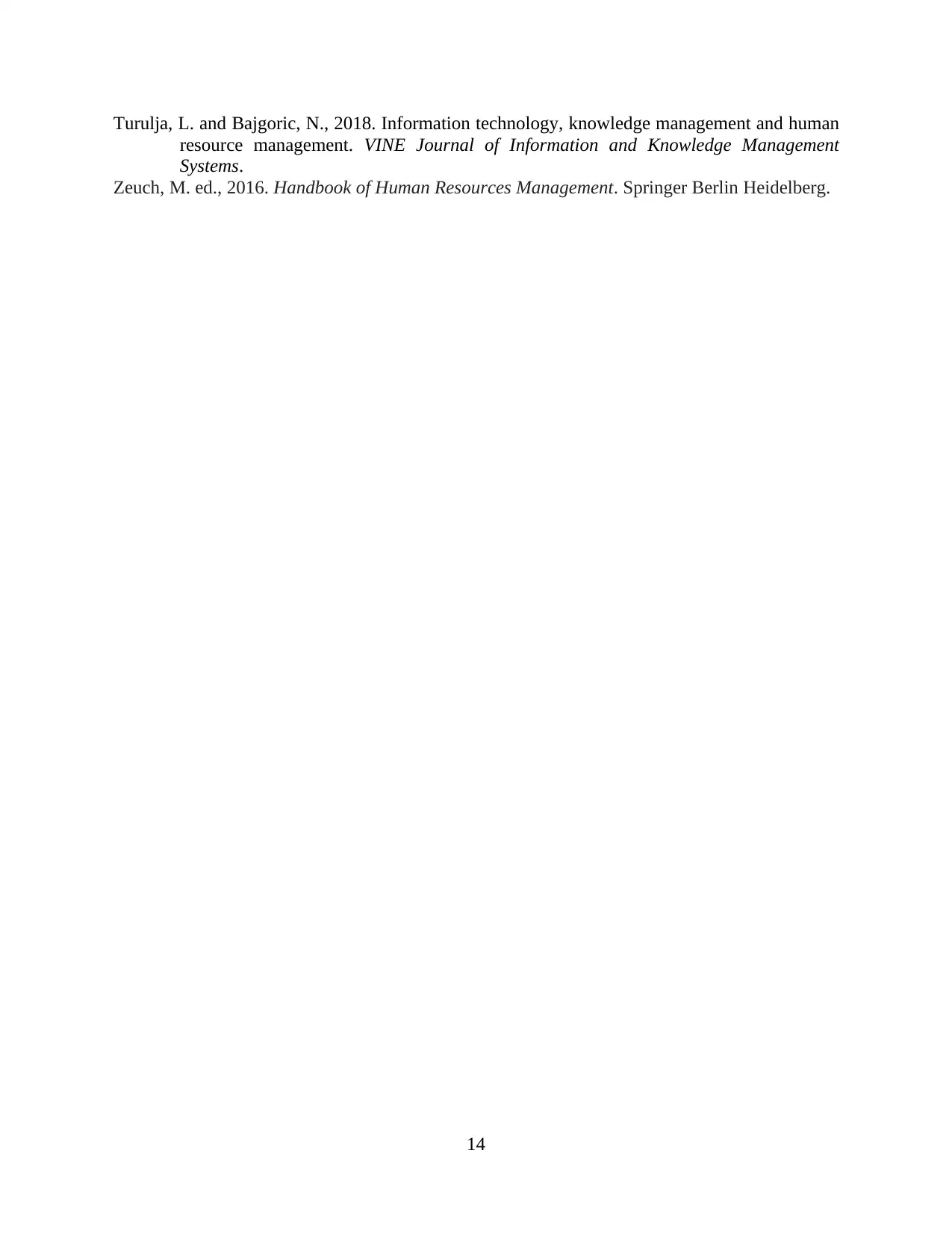
Turulja, L. and Bajgoric, N., 2018. Information technology, knowledge management and human
resource management. VINE Journal of Information and Knowledge Management
Systems.
Zeuch, M. ed., 2016. Handbook of Human Resources Management. Springer Berlin Heidelberg.
14
resource management. VINE Journal of Information and Knowledge Management
Systems.
Zeuch, M. ed., 2016. Handbook of Human Resources Management. Springer Berlin Heidelberg.
14
1 out of 16
Related Documents
Your All-in-One AI-Powered Toolkit for Academic Success.
+13062052269
info@desklib.com
Available 24*7 on WhatsApp / Email
![[object Object]](/_next/static/media/star-bottom.7253800d.svg)
Unlock your academic potential
© 2024 | Zucol Services PVT LTD | All rights reserved.





